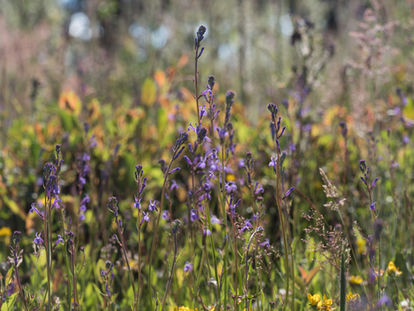Flies
43 species of fly have become extinct in England in the last 200 years, 10 of which are shown below

Species: Belida angelicae
Extinct: 1936

Species: Clitellaria ephippium
Extinct: 1850
© John Reinecke
© Hectonichus


HEATH LOBELIA
Lobelia urens

One of our few native Lobelias which forms a blaze of purple in damp heathlands and grasslands.
-
Rarity: occurring at only 7 sites across the south of England, from Cornwall to Sussex. These are extremely vulnerable and many support perilously low numbers of plants.
-
Cause of decline: Loss of heathland sites, a decline in extensive grazing practices and a deterioration in habitat quality in its remaining sites.
Background
Heath Lobelia is a rare member of the Lobelioideae, a family of plants which are more commonly encountered in the tropics. As such, it is a spectacular site in British heathlands and has been the subject of intense conservation work for several decades.
It occupies a niche in damp heathlands and acid grassland that are subject to sporadic heavy disturbance - an environment that would have been common when extensive herds of grazing animals moved freely within the landscape, but is now an almost vanished habitat type.
There are only seven native sites in the UK, all within southern England. Historically, the decline of this species is linked to afforestation and cultivation of sites but more recently a loss of management at several of its remaining sites.
Ecology and Conservation
Heath Lobelia is a perennial herb which overwinters in rosettes of leaves, producing flower spikes in spring. The beautiful, 2-lipped, purplish blue spikes grow to around 60cm tall, and are insect or self-pollinated. Pods produce large quantities of seeds, which we believe to persist in soils for long periods of time.
In southern England, the plant is found on acid grassland and dwarf shrub heath, rough pastures and damp, often waterlogged, acid soils. It is not a true damp heath species and is often associated with rush and other damp-loving species.
Decline of our heathlands and niche habitat requirements have seen devastating declines of this species. As with so many other rare species it appears to thrive most following periods of relatively high disturbance, and therefore can thrive in habitats subjected to commons-style intense periodic grazing, a hard feat to pull off in today’s fragmented landscape.
Our Work
Our work on this species focuses on annual monitoring of all extant sites to increase our understanding of the ecology and habitat requirements of this exquisite plant. This informs required management, and with help from our volunteers we perform tasks such as scrub removal, disturbance creation & introduction of herbivores. In recent years we have moved to gradually re-introduce the species to its lost sites.
Through extensive surveying, it has been found that populations can fluctuate greatly from year to year, and so localised extinctions remain a threat, particularly where those are low in numbers. Each year this monitoring gives us a clearer picture of the exact ecological requirements of this species, and how best to save it.








